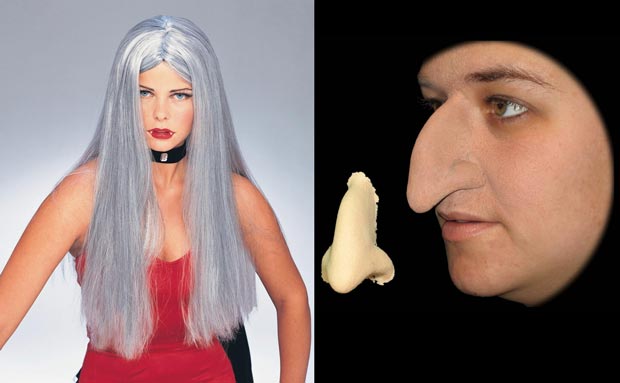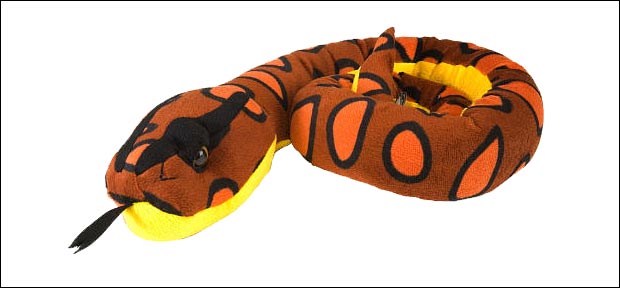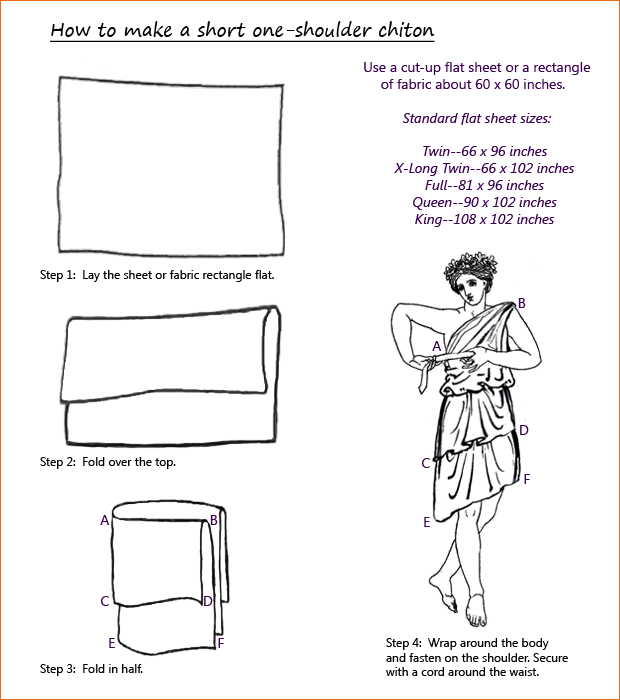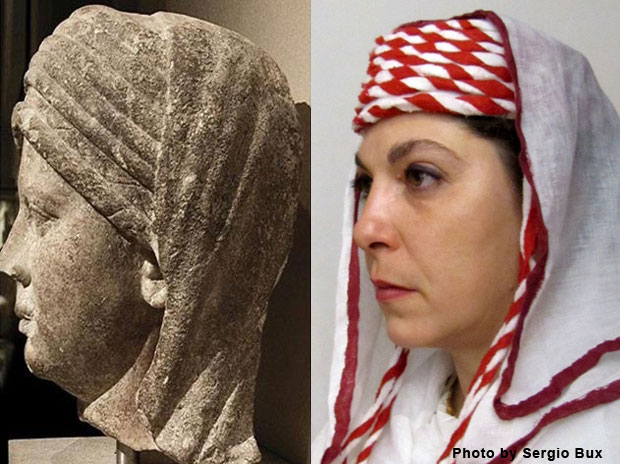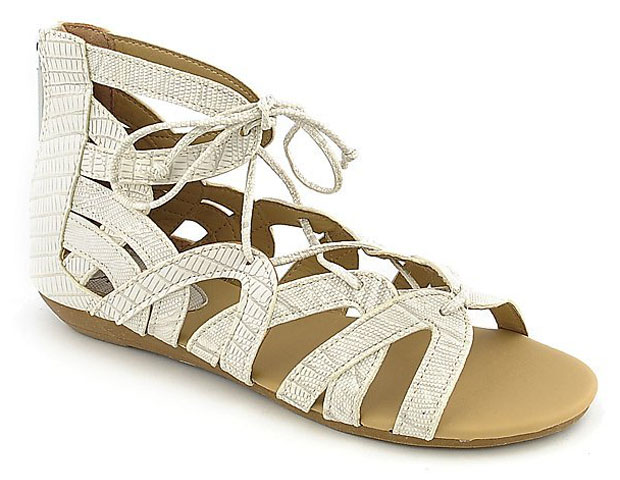Madam C.J. Walker (1867-1919) was America’s first great female entrepreneur. Her rags-to-riches story still mesmerizes: born Sarah Breedlove, the daughter of slaves, she built a business empire by developing and marketing a line of hair care products for African American women. (She did not invent the hot comb or chemical straighteners, as is commonly believed; her formulas were designed to cleanse and condition the hair.) By 1917 the Madam C.J. Walker Manufacturing Company was the largest black-owned business in the United States, providing career opportunities for thousands of African American women. Madam Walker herself may have been the first American woman of any race to become a self-made millionaire.
 She was also a pioneering philanthropist, donating enormous sums to the NAACP, Tuskegee Institute, YMCA, YWCA, and Bethune-Cookman College. Her commitment to the community was matched only by her passion for empowering women to become financially self-sufficient. In her will she stipulated that the president of the Walker company must always be a female.
She was also a pioneering philanthropist, donating enormous sums to the NAACP, Tuskegee Institute, YMCA, YWCA, and Bethune-Cookman College. Her commitment to the community was matched only by her passion for empowering women to become financially self-sufficient. In her will she stipulated that the president of the Walker company must always be a female.
Our costume is based on the photographs of Madam Walker in elegant daytime attire. The pieces we suggest, from left to right:
1. Ladies’ Edwardian suit in navy. Also available here. This is a real two-piece suit of quality construction, not a cheapo costume item. It comes in three different colors; we chose the navy, which has ivory trim. The blouse is not included.
2. Ivory satin “Josephine” blouse. This superb blouse has a stand-up collar, four-button cuffs, and elegant Venetian lace down the front. It looks wonderful with the Edwardian suit.
3. Lavender and ivory touring hat. This is a beautiful hat with gorgeous feathers and lace, but you can save money by trimming a hat yourself. It’s not difficult if you’re at all creative or handy. Just get a basic straw hat and go to your local crafts store. Pick out some silk flowers, feathers, and ribbon that look good together, plus some long straight pins. Tie a big ribbon around the crown of the hat, and use the pins to attach the flowers and feathers. Just make sure the sharp ends of the pins don’t come through the hat and poke you in the head.
4. Cameo brooch with crystals and topaz dangle. Daytime jewelry in the period was subdued but elegant. We think Madam Walker wore cameos, and this one looks very pretty with the blouse and hat. Pin it on your collar right at the base of your throat.
5. Lace-up boots in ivory. These are wonderful period boots. They even have lace panels on the sides, which matches the other lace in our costume.
6. Wrist length satin gloves in ivory. Madam Walker would have worn kid gloves, but these are a much less expensive alternative.
Optional corset: It’s not required, but a corset will definitely help give you the correct period silhouette.
Learn more: A’Lelia Bundles is the great-great-granddaughter of Madam Walker and has written the definitive biography of her: On Her Own Ground: The Life and Times of Madam C.J. Walker. Visit the official Madam C.J. Walker website to learn more. Ms. Bundles is currently working on a biography of her namesake, A’Lelia Walker (Madam Walker’s only child), who was a central figure in the Harlem Renaissance. Check out the official A’Lelia Bundles site for more info.
Baba Yaga is the legendary witch of Slavic folklore, particularly Russian fairy tales. She lives on the edge of the forest in a hut that stands and moves on chicken legs. Baba Yaga herself fills the hut from end to end, stretched out on her stove with her nose growing into the ceiling. She travels through the air in a mortar, pushing herself along with a pestle and sweeping away her tracks with a broom. She also likes to eat people.
Baba Yaga is probably descended from a pre-Christian goddess of death, and many of the deliciously weird elements in her myth can be understood as holdovers of ancient symbolism. Our costume was particularly inspired by Marija Gimbutas’s description of Baba Yaga’s hut (emphasis added):
Baba Yaga never walks; she either flies in a fiery mortar or lies in her hut on bird’s legs. The fence around the hut is made of human bones and topped with human skulls with eyes intact…The hut can turn around on its axis like a spindle and is, in fact, Baba Yaga herself. (The Language of the Goddess, 1991)
 So, if Baba Yaga is one with her hut, then…can’t she also have chicken legs? Why, yes! Yes she can! The items we suggest, from left to right:
So, if Baba Yaga is one with her hut, then…can’t she also have chicken legs? Why, yes! Yes she can! The items we suggest, from left to right:
1. Red flannel nightgown. Another option is here. A long flannel nightgown works great as a house dress.
2. One yard of skulls-and-flowers calico to use as an apron. At first glance this looks like a classic Russian calico, with multicolored flowers on a black background. It’s only when you look more closely that you realize there are skulls in there. Psychedelic skulls! To use this as a full-length apron, just pin the top of the fabric to your nightgown at chest level and use a string or belt to secure it around your waist. (It’s not like it has to look good. Baba Yaga is not known for her sartorial splendor.)
3. Black creepy cloth. Wrap some of this around you as a raggedy shawl.
4. Skull garland. The garland is 68 inches long and has 8 foam skulls, each about 2 inches high. Get a couple of these, one to drape around your shoulders as a giant necklace and another to wrap around your waist.
5. Blue skulls head scarf. Wear this babushka style: fold it in half as a triangle and tie it under your chin.
6. Costume chicken feet. You are one with your hut. If these chicken feet aren’t in stock, just wear flat boots or booties. You could also consider lapti (bast shoes), but these tend to be pricey souvenir items outside of Eastern Europe. UPDATE 10/6/2013: The chicken feet do seem to be sold out at the first store, but this place reportedly still has a couple of sets in stock.
Hair and makeup: You’ll need long gray hair and a great big nose (below). Note that you’ll also need spirit gum to attach the nose, and a boatload of foundation and powder to make it blend in. Use black eyeshadow to make huge dark circles around your eyes. You can also enhance your eyebrows with white or gray makeup.
Broom: The brooms that are sold online tend to be very small, so the best thing is to go to a local craft store. They usually have nice twiggy brooms in stock for Halloween.
Main illustration credits: The marvelous model of Baba Yaga’s hut in the upper right corner is by artist Forest Rogers. The other images are all Russian lacquer pieces depicting Baba Yaga and her hut.
Asase Yaa is the earth goddess of the Asante people in Ghana. She created human beings and receives them back into her body when they die; she is also the mother of the gods. There are no temples to her, for the earth itself is both her body and her temple. There are also no standard anthropomorphic depictions of her, which means we’re free to come up with our own costume. Our design is a blend of inspirations: the kente cloth and fabulous gold jewelry of Ghanaian royalty (inset photos in our main illustration); the green plants and sparkling gems that are the gifts of the earth; and the libations that farmers pour out to Asase Yaa in their fields.
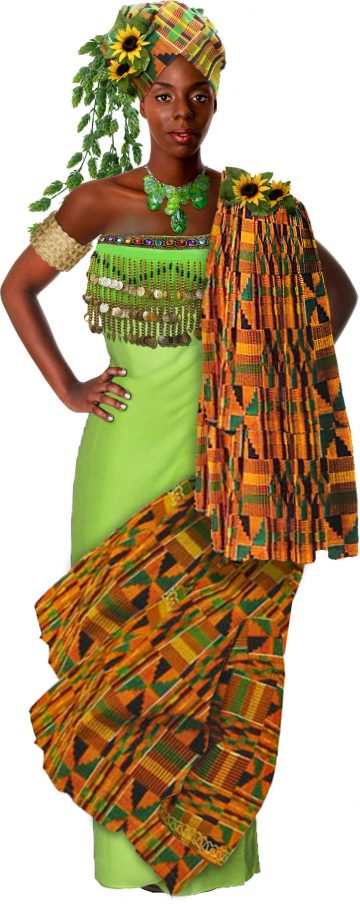 The pieces we suggest, from left to right:
The pieces we suggest, from left to right:
1. Lime green sarong for your base layer. Wrap this around your body just under your arms—like a giant bath towel—and pin it along the sides to shape it into a full-length gown. This particular sarong is extra-long; if you get regular or half-size sarongs, you’ll need to use two and layer them together (one around your waist for the lower skirt and the other under your arms for the top half).
2. Lime green scarf with gold coins. This velvet scarf is an easy way to transform your sarong into a jeweled extravaganza. It’s about 55 inches long by 9 inches deep, and has faux gemstones along the top edge and three rows of very shiny goldtone coins. Wrap this around you at the top edge of your sarong, just under your arms, and tie in the back.
3. Bolt of kente print cloth. The bolt is 12 yards long and 45 inches wide. You’ll need to cut off one 15″ x 72″ piece at the bottom for your headwrap; see below for a cutting guide and a video on how to tie it. The remainder of the bolt—about ten yards—you’ll use as a big toga-like wrap. Begin by throwing about three feet of the fabric backwards over your left shoulder. Wind the bulk of the material around you in a big loop, from front to back, and bring it up behind you to your left shoulder; pin in place. With ten yards, you’ll have enough fabric to do this loop around your body twice. Finish off by throwing the last three feet of the fabric forward over your left shoulder to hang down in front.
4. Artificial hops vine and artificial sunflowers. The most popular libation to Asase Yaa is beer, poured out on the ground during naming ceremonies and other important rituals. This hops vine is 30 inches long and looks great cascading out of the headwrap. Snip individual sunflower blossoms to decorate your headwrap and to cover up the pins on your left shoulder.
5. Chunky green necklace and earring set. We absolutely love the color and gleam of these huge crystals.
6. Goldtone stretch bracelet. Gotta have more gold. We show one bracelet, but really, just pile on as many as you can.
Shoes: Gold sandals would be ideal.
Bonus points: Carry a beautiful Bolga basket from Ghana. These are fair-trade imports from Tango Zulu, with lots of different sizes and prices. You could fill it with Halloween candy, fruit, flowers, or decorative ears of corn (corn is a huge crop in Ghana).
Making the headwrap: The full bolt of kente print cloth is 12 yards long. Here’s a scale diagram:
First cut off the bottom two yards (72 inches) from the bolt. (The other ten yards is for your main toga-like wrap.) This will give you a piece of fabric that is 72 inches long and 45 inches wide. From that piece, cut one headwrap that is 15 inches wide and 72 inches long. This is a good basic size for tying around your head. The leftover piece is 72 inches by 30 inches; you can also experiment with using that as a headwrap, especially if you want to do something very big and elaborate.
Here’s a great video from Dupsie’s that shows the basic way of tying a headwrap:
Will Rogers called her “the greatest woman rifle shot the world has ever produced.” The Associated Press dispensed with the female qualifier in her obituary, calling her “perhaps the greatest shooter of all time.” Sitting Bull famously nicknamed her “Little Sure Shot.”
Annie Oakley (1860-1926) was born poor, and originally took up shooting as a way to feed her family. Her incredible skill eventually made her the star of Buffalo Bill’s Wild West Show and an international sensation. She could hit any target, it seemed, no matter how tiny. She could shoot the heart out of a playing card, or, if the card was held sideways, split it in half. She could shoot the ash off a cigarette and the cork out of a bottle. She could shoot upside down, backwards, looking over her shoulder in a mirror, anything. And she was consistent: one of her fellow sharpshooters said it was simply impossible to beat her. She was like a machine.
Annie designed and sewed her own costumes, combining practicality with a frontier aesthetic and a strong sense of personal modesty. Her outfits were never even a tiny bit revealing, but they gave her the freedom of movement she needed. The pieces we suggest, from left to right:
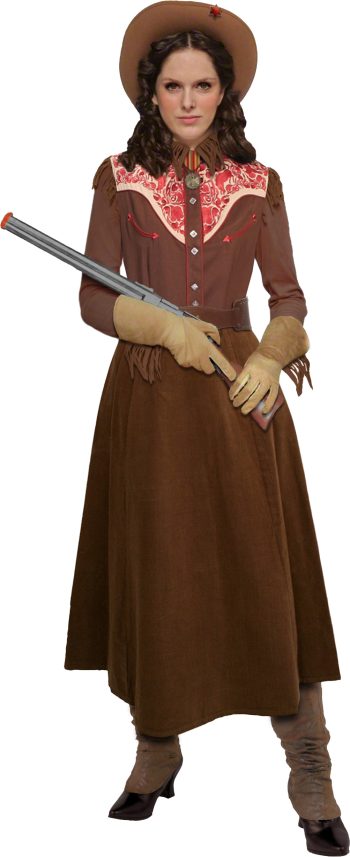 1. Scully western blouse in brown plus optional brown suede fringe. The blouse is also available here and here. The only thing we suggest you add to it is a little bit of brown suede fringe, which we also use on the gloves (next). It’s not required, but it does help tie it all together and make it look like one of Annie’s outfits. Use Res-Q tape or Aleene’s Tack-It Over & Over to temporarily attach a row of fringe to the collar. We added a little bit of fringe at each shoulder for good measure.
1. Scully western blouse in brown plus optional brown suede fringe. The blouse is also available here and here. The only thing we suggest you add to it is a little bit of brown suede fringe, which we also use on the gloves (next). It’s not required, but it does help tie it all together and make it look like one of Annie’s outfits. Use Res-Q tape or Aleene’s Tack-It Over & Over to temporarily attach a row of fringe to the collar. We added a little bit of fringe at each shoulder for good measure.
2. Womanswork gauntlet gloves plus optional brown suede fringe. Glue a strip of the suede fringe to the gauntlet seam to give these garden gloves some western flavor and help tie them in with the blouse. Alternate gloves, slightly cheaper: Angela’s Garden gauntlet gloves.
3. Brown twill skirt. Alternate skirt: A-line chocolate twill skirt. Basically you just need a full skirt in a sturdy twill that’s about the same color as the blouse. You want the skirt to be tea length at most, so depending on how tall you are and which skirt you get, you’ll probably need to turn up the hem. Res-Q tape makes it easy. (If you get ambitious, there’s nothing stopping you from buying a few yards of that same brown suede fringe and edging the whole bottom of the skirt with it.)
4. Brown faux leather gaiters.
5. Brown felt gambler hat by Jacobson. Also available here.
6. Costume medals and a red star pin (from eBay). Annie Oakley was famous for wearing a six-pointed star on the upturned brim of her hat. Gold or silver would be great, but we chose this Army surplus red star pin because it looks good with the blouse. Annie also liked to wear her shooting medals. We chose to use one medal pinned at the collar where a necktie would be, just like Annie is wearing in the big studio portrait in our main illustration.
Toy rifle: If you’re thinking of carrying a toy gun as a prop, first make sure you won’t be breaking any laws. It’s illegal in some places to carry toy guns in public. And even if it’s not illegal, it can still be dangerous. People have died because somebody mistook a toy gun for the real thing and overreacted. But if you are looking for a prop gun to use in a totally safe way in a non-public locale, the 30″ Winchester Model 1894 toy rifle is a good choice:
Marie Laveau (1801?-1881), better known as the Voodoo Queen of New Orleans, is one of the most mysterious figures in American history. Almost all the facts of her life are shrouded in legend and confusion, beginning with the date of her birth (popular sources often cite 1794, but the records indicate 1801). All we can really be sure of is that she was a free woman of color who became the most powerful Voodoo leader in New Orleans. Thousands of people in the city—black, white, gens de couleur—flocked to her unique blend of Catholicism and African spirituality. New Orleans Voodoo was a religion, and Marie Laveau was its pope, priestess, and prophet.
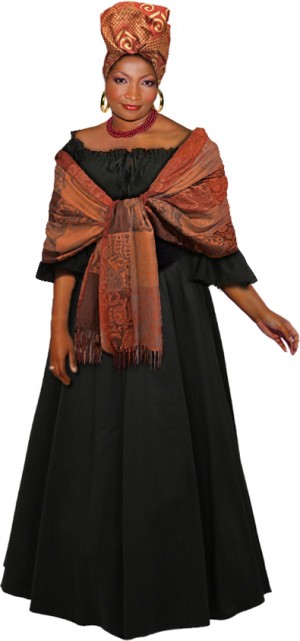 There are no surviving images of Marie Laveau. The most famous portrait of her (foreground of our main illustration) was actually painted in the 1920s, though it’s based on illustrations from the 1830s. That’s when Marie would have been in the prime of life. Free women of color in those days wore a tignon, which was simply the French New Orleans version of an African head wrap. They also wore fashionable gowns—the 1830s silhouette featured full skirts, full sleeves, dropped shoulders—and large shawls. The pieces we suggest, from left to right:
There are no surviving images of Marie Laveau. The most famous portrait of her (foreground of our main illustration) was actually painted in the 1920s, though it’s based on illustrations from the 1830s. That’s when Marie would have been in the prime of life. Free women of color in those days wore a tignon, which was simply the French New Orleans version of an African head wrap. They also wore fashionable gowns—the 1830s silhouette featured full skirts, full sleeves, dropped shoulders—and large shawls. The pieces we suggest, from left to right:
1. Black chemise top. This came from an eBay seller who is no longer in business; she advertised her items as “renaissance” and “pirate wench” outfits. It’s basically a sort of peasant blouse with an elasticized top. You can wear it a little off your shoulders for an 1830s look. Tuck it into your skirt and cinch it all with the belt.
2. Black skirt. This matches the chemise top. You basically just need a full black skirt.
3. Black velvet belt. The V-shaped waist was very fashionable in the 1830s and 40s, and this belt is a super easy way to create that silhouette.
4. Paisley shawl in rust and gold.
5. Head wrap in brick red and beige. We’re using an African head wrap from Dupsie’s to recreate the look of Marie’s tignon. Hers would have been Madras plaid, but we chose an African print that looks really good with the shawl. We include a couple of videos below with instructions on how to tie it.
6. Jewelry: gold hoop earrings. According to people who knew and remembered her, Marie always wore gold hoop earrings. The red beads are a New Orleans touch.
Extra credit: It’s said that Marie Laveau danced by the shores of Lake Pontchartrain with her huge pet snake Zombi wrapped around her shoulders. Assuming you don’t really have a pet snake, you can go with this Wild Republic 54″ plush boa constrictor instead:
Tying the head wrap: The good folks at Dupsie’s have uploaded some very useful videos showing how to tie an African head wrap. The principles are exactly the same for a New Orleans tignon, though you’ll need to practice and experiment to get it to look the way you want. The first video shows the basic tying technique, while the second video shows a front-tie variation::
Learn more: The most accurate, careful book about Marie Laveau is A New Orleans Voudou Priestess: The Legend and Reality of Marie Laveau by Carolyn Morrow Long. If you really want to sort fact from fiction, that’s where to go.
Main illustration credits: The large background image is a 1977 painting of Marie Laveau by Charles Gandolfo, featured at the New Orleans Historic Voodoo Museum. The Marie Laveau portrait in the foreground was painted by Frank Schneider in the 1920s, apparently based on an 1830s portrait by George Catlin of an unidentified woman. It’s in the collection of the Louisiana State Museum.
Athena is easily the best-known and most popular Greek goddess. Yet none of the so-called “Athena” costumes for sale out there look remotely like her. Come on, people! She’s Athena! Helmet! Shield! Spear!
There were two very important statues of Athena on the acropolis in ancient Athens. The colossal statue inside the Parthenon was 38 feet tall, with the clothing made entirely of gold. The smaller wooden cult statue was life-sized, and dressed in a special gown made every year by the women of Athens. This dress was actually a tapestry, with scenes of mythological battles woven in purple and saffron. We can’t lay our hands on anything like that for our costume, but we are including a purple himation (wrapped cloak) with gold threads. The pieces we suggest, from left to right:
 1. Gold satin flat sheet. This is for your tunic. The Greeks wore simple draped tunics of dyed wool, a look which is easily replicated with sheets and safety pins. We give you instructions below on how to pin it together. A full size sheet will work for most people.
1. Gold satin flat sheet. This is for your tunic. The Greeks wore simple draped tunics of dyed wool, a look which is easily replicated with sheets and safety pins. We give you instructions below on how to pin it together. A full size sheet will work for most people.
2. Purple veil with gold and silver threads. Also available at Moondance and Artemis Imports. This is your purple himation. Loop it under one arm and knot it on your opposite shoulder.
3. Greek helmet. This is from the movie 300, which is as close as we’ll get to a Greek helmet without paying a fortune. We suggest cutting off the nose piece. This is a very flimsy latex helmet, so don’t expect a lot. Another option is this helmet
, which seems to have real bristles in the crest (not molded plastic). The helmet itself is definitely made out of fabric, so you can cut and trim it to suit.
4. Greek shield. Another 300 movie prop.
5. Greek spear. Same deal.
6. Plush 9″ barn owl. Adorableness is not a trait usually associated with Athena, but this stuffed owl is adorable. Use safety pins to attach it to your shoulder at the place where your cloak is knotted. The owl is Athena’s totem animal; in fact, when you get right down to it, Athena is an owl. She’s the Neolithic bird goddess: owl-eyed Athena.
Optional snake armband: The snake is the other animal associated with Athena. Her statue in the Parthenon was accompanied by a humongous rearing snake, worked in gold like the rest of the sculpture. If you want to incorporate some snake references in your costume, you might consider a fat snaky armband like this. Athena doesn’t wear jewelry, so this would be your only ornament.
Shoes: Gold gladiators would be ideal. If you don’t have those, just basic flat leather sandals will work.
How to make the tunic: The simplest ancient tunic for costuming purposes is the Doric chiton, which consists of a single rectangle of fabric folded around the body. All you need is a flat sheet, some safety pins, and a belt or cord. (You can get a rope belt here in white, natural, or gold.) Here are your chiton instructions:
And finally, the Gorgon situation: If you know your Athena iconography, you know our costume is missing something: the Medusa head on Athena’s breastplate. That’s because we haven’t found a good solution for that. The ideal thing would be a lightweight latex mold of a Gorgon, but we can’t find such a thing. The closest we can get is this cast stone wall plaque. It’s the right style and the right size, but it weighs two pounds. That would be one heavy necklace. UPDATE: Reader Ember Cooke writes in with an excellent suggestion on how to incorporate a Gorgon in the costume:
Get one of those plastic face masks (like this, maybe) and some little toy snakes (like these). Just spray paint them the colors you want them to be, and glue them to your shield. It should be much less heavy than a stone casting.
Although if you HAD a stone casting, you could wrap it in plastic wrap, and then soak some cloth in watered-down Elmer’s Glue and drape it on top of the mold, poking it into the nooks and crannies to make sure it takes on the right shape. Once it dries, you can glue it to your shield or wear it or whatever. I have masks I made that way out of felt or cheesecloth that have held their shape for years. Super easy.
Those are wonderful ideas. Thank you so much, Ember!
Illustration credits: The central painting in our main illustration is The Akropolis of Athens by Leo von Klenze. The painting in the lower right corner is Pericles And Pheidias Consult About Creation Of Statue Of Athena by H.M. Herget. We don’t know the provenance of the image in the upper right corner.
Ah, Artemis! Goddess of the wilderness, mistress of the moon, patron of untrammeled womanhood. She races through the hills with her beloved animals, fleet-footed and shining. Artemis is one of the most venerated deities in all of Greek mythology, not to mention one of the most complex. She may be descended from a Neolithic Great Goddess, which would explain why she’s somehow in charge of virginity and childbirth and animals and hunting and the moon.
For the costume, we imagined Artemis in midnight blue and gleaming silver, like a vision of the moon in the night sky. She carries the silver bow especially made for her by the Cyclopes and is accompanied by her sacred golden stag. The items we suggest, from left to right:
1. Navy blue flat sheet to use as as a chiton (tunic). The ancient Greek chiton is incredibly easy to rig up; it’s just a rectangle of fabric folded around the body. We give you instructions below.
2. Two or three yards of silver tissue lame to use as a sash. Just wind it around your waist.
3. Bow and arrow set. This is an inexpensive plain wooden set, which you can use as is or transform with silver metallic spray paint. The arrows are kind of dinky, so you may want to buy an extra set.
4. Back arrow quiver. Inexpensive black vinyl, which can be transformed with that same silver metallic spray paint.
5. Crescent moon circlet at Tomas the Lapidary. A simple, beautiful circlet of German silver. If you want something fancier, check out Dawn Hill Designs or Wynddragon’s Treasures to see what they have in stock.
6. Adorable plush deer. Useful if you plan on standing around a lot in your costume. Otherwise, not so much. But still adorable!
Shoes: Silver gladiators, obviously.
Arm band: We used a bright silver-tone steel cuff that literally cost 4 dollars. It’s no longer available, but this set from Amazon offers similar possibilities.
How to make the chiton (tunic): The oldest kind of Greek chiton was just a rectangle of fabric folded around the body. Women usually wore a long chiton, but Artemis was frequently depicted wearing the short chiton of a man or pre-adolescent girl. All you need is a sheet or rectangle of fabric, safety pins, and a belt or cord. Here’s how to do the one-shoulder version we used for the costume:
If you want to be a little more covered up, check out our Hypatia page. We have instructions there for both the full-length Doric chiton and the Ionic chiton.
Main illustration credits: The background is an image of the famous statue of Artemis in the Louvre. It’s called the Diana of Versailles, and is thought to be a first or second century Roman copy of a Greek original. The gorgeous modern painting on the right is Artemis by Raine Szramski.
Isis is the Egyptian goddess of magic and motherhood, but putting it that way rather understates the case. Isis is simply one of the all-time great goddesses of world civilization. Worshiped by the Egyptians for thousands of years, she also became supremely important in the Hellenistic world. She was everything: mother, savior, redeemer, goddess of wisdom and healing, fount of fertility and rebirth, teacher of arts and skills. Her roots lie deep in the African Neolithic; she may be the original bird goddess, her huge outstretched wings sheltering those in her care.
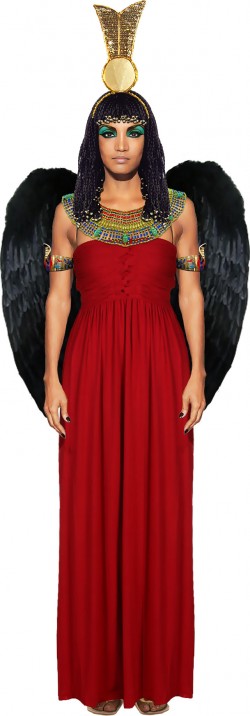 The Egyptians associated Isis with the color red, addressing her as “thou lady of the red apparel.” She’s usually depicted wearing the archaic Egyptian sheath dress, which was nothing more than a tube of fabric with straps. A modern maxi dress is a comfortable substitute (though if you want to try making an Egyptian sheath, this page has excellent instructions). The pieces we suggest, from left to right:
The Egyptians associated Isis with the color red, addressing her as “thou lady of the red apparel.” She’s usually depicted wearing the archaic Egyptian sheath dress, which was nothing more than a tube of fabric with straps. A modern maxi dress is a comfortable substitute (though if you want to try making an Egyptian sheath, this page has excellent instructions). The pieces we suggest, from left to right:
1. Red maxi dress. We used the Type Z Liliana Maxi Dress in red, but any strapless gown like this will work well with the collar (#2) and the wings (#5). A long sundress with straps would also work.
2. Egyptian beaded collar.
3. Egyptian armbands.
4. Hathor crown. The Hathor crown was originally associated with the goddess Hathor—hence the name—but Isis wore it too. It represents the solar disk within a pair of horns, sometimes with two upright feathers as well. That costume item seems to go in and out of availability, so an alternate choice is this Egyptian vulture crown. This was the headdress particularly associated with queens, and Isis was sometimes shown wearing it (Isis took on a lot of symbolism as her popularity grew).
5. Huge black feather wings. These are seriously big wings. They don’t move, but you’ll still look like a giant Black Kite (Milvus migrans, the bird form of Isis).
6. Egyptian-style wig. If you can’t do your own hair into an Egyptian style, a wig like this will fix you up.
Makeup: You’ll want to do dramatic eye makeup, with industrial-strength eyeliner and the lines drawn all the way out to your temples. There are a plethora of YouTube videos and instructionals out there. Consider using green eyeshadow, since malachite was the Egyptians’ favorite cosmetic for eye color.
Shoes: Egyptian deities were usually depicted barefoot, while pharaohs wore exquisitely made sandals covered in gold foil. (The Discovery Channel has an interesting set of slides showing sandals from King Tut’s tomb.) Since you probably don’t want to go barefoot, we recommend going the pharaoh route with something like these Max Collection Mirage sandals in gold:
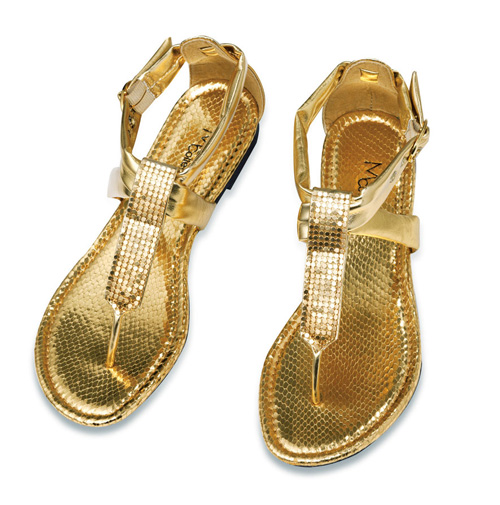
Pirates of the Caribbean! Real pirates, that is: Anne Bonny (1690s-?) and Mary Read (1690s-1721). They sailed the high seas with the infamous Calico Jack, and so much has been written about the three of them that we can’t possibly squeeze it in here. We need all the space just to talk about the costumes, since we’re doing both of them on this one page. Instead we’re going to direct you over to Forgotten Newsmakers for a biographical sketch.
With the costumes, we’ve tried to split the difference between the fanciful Hollywood image of a pirate—long coat, cavalry boots—and the grimy reality of everyday pirate clothing in the early 18th century.
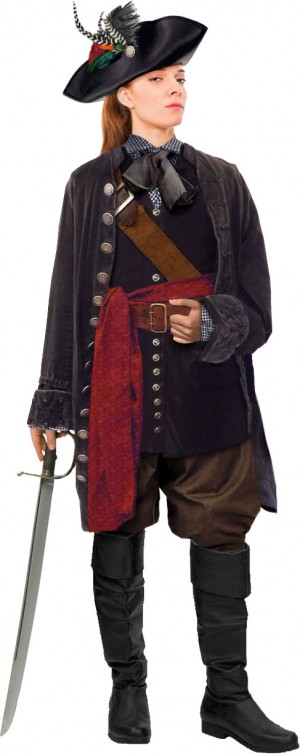 Anne Bonny is dressed like a pirate on shore leave, parading around in a combination of stolen finery and sailor slops. She’s wearing a blue check workshirt—ubiquitous naval garb in the 18th century—but she’s topped it off with a rather fancier black silk cravat. Her stolen black velvet coat is a bit too big for her, as is the matching velvet waistcoat. Her pants are rough brown trousers, stuffed into tall black boots that once graced the legs of a Spanish grandee. On her head she wears a leather tricorn spruced up with feathers and a silver button. A calico sash, a belt, and a baldric complete the picture.
Anne Bonny is dressed like a pirate on shore leave, parading around in a combination of stolen finery and sailor slops. She’s wearing a blue check workshirt—ubiquitous naval garb in the 18th century—but she’s topped it off with a rather fancier black silk cravat. Her stolen black velvet coat is a bit too big for her, as is the matching velvet waistcoat. Her pants are rough brown trousers, stuffed into tall black boots that once graced the legs of a Spanish grandee. On her head she wears a leather tricorn spruced up with feathers and a silver button. A calico sash, a belt, and a baldric complete the picture.
1. Shirt and tie: Authentic 18th century blue check cotton workshirt with a black silk cravat.
2. Coat and waistcoat: Captain De Lisle black velvet coat with the a matching black velvet vest. If the buttons are a little too new-looking, you can tone them down with Rub-N-Buff.
3. Pants: Brown drawstring pants.
4. Footwear: Over-the-knee boots, worn with the top folded down. Tall boots like this were designed for cavalry, and pace Johnny Depp, they’re not the sort of thing a pirate would normally wear. But this is a special occasion.
5. Headgear: Leather tricorn hat decorated with feathers. It’s expensive because it’s a real hat. Use thread to tie the feathers and a spare silver button to the cross-stitched “X” on the side of the hat.
6. Sash: You don’t need to buy a pre-made sash. Just get a length of crimson paisley print fabric (108 inches wide) and wrap it around your waist. Ragged edges are good.
Sword: Pirates of the Caribbean Sword.
Belt and baldric: The baldric is the cross belt worn over one shoulder, designed to hold a sword or pistol. You can buy new baldrics and belts, or just use some old belts from your closet. If you don’t need a fancy baldric with a fitted weapon holder, just sling a long belt over your shoulder and cinch it under your coat, the way Anne has done here.
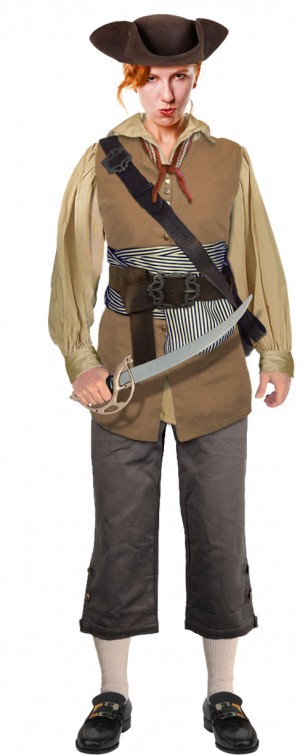 Mary Read is dressed like a pirate on ship duty: grubby and practical. Her workshirt is the color of natural linen; her red sailor’s neckerchief has aged to a muddy brown. She wears no coat, though if she did it would be a short jacket, suitable for clambering around decks. Her waistcoat is made of sturdy brown canvas. The knee buttons on her breeches can be left undone for maximum ease of movement. Like virtually all sailors of the period, she wears shoes rather than boots. Her serviceable brown tricorn hat is undecorated. The sash around her waist is made of blue ticking—a standard naval fabric—and the ends are looped up and tucked in. (No long trailing sashes on board ship—they’d just get in the way.)
Mary Read is dressed like a pirate on ship duty: grubby and practical. Her workshirt is the color of natural linen; her red sailor’s neckerchief has aged to a muddy brown. She wears no coat, though if she did it would be a short jacket, suitable for clambering around decks. Her waistcoat is made of sturdy brown canvas. The knee buttons on her breeches can be left undone for maximum ease of movement. Like virtually all sailors of the period, she wears shoes rather than boots. Her serviceable brown tricorn hat is undecorated. The sash around her waist is made of blue ticking—a standard naval fabric—and the ends are looped up and tucked in. (No long trailing sashes on board ship—they’d just get in the way.)
1. Shirt and tie: Cotton shirt in natural with a dark red bandana.
2. Coat and waistcoat: No coat. The waistcoat is the Ansell 1720 Vest in aged brown.
3. Pants: Knee breeches in brown.
4. Footwear: Shoe buckles. These are just the buckles, not the shoes. They’re a cheap but simple way to transform an existing pair of black shoes into something that looks more 18th centuryish. Wear white over-the-knee socks to simulate the look of knitted stockings.
5. Headgear: Brown tricorn hat. This is just a costume hat, but it’s not bad looking.
6. Sash: Striped ticking was a common fabric on seagoing vessels in the 18th century. Get a couple of yards of ticking stripe fabric and wrap it around your waist. Tuck in the loose ends for a practical look.
Sword: Pirate cutlass.
Belt and baldric: Mary is wearing the baldric and one of the belts from a Jack Sparrow replica set. (The baldric is the cross piece worn over one shoulder.) You can also shop for baldrics and belts from the reenactment people, or just use some old belts from your closet.
Related posts: Last-minute Mary Read (or Anne Bonny) and Pirates of the Caribbean (for real): Anne Bonny and Mary Read.
Illustration credits: The center of our main illustration is a two-page layout from DK Eyewitness Pirate, a wonderful book that we thoroughly recommend. The two woodcut illustrations at the bottom are from A General History of the Robberies and Murders of the Most Notorious Pyrates, originally published in 1724. That’s the earliest known depiction of Anne Bonny and Mary Read (color added later); the sepia-toned gentleman to their left is Calico Jack. The two trading cards at the top are from “Pirates of the Spanish Main,” an 1888 trading card set issued by Allen & Ginter. Anne Bonny’s card is on the left and Mary Read’s is on the right.
Ada Byron Lovelace (1815-1852) was one of the most remarkable visionaries in the history of science. Her friend Charles Babbage invented the Analytical Engine to crunch numbers; it was Ada who realized that it could do much more. She saw that a mechanical device—a computer, if you will—could solve all kinds of analytical problems, as long as they could be treated algorithmically. She was a hundred years ahead of her time. Nowadays she’s recognized as “the world’s first computer programmer,” though we think that actually understates the novelty and breadth of her vision. It makes her sound a little like an early employee at IBM.
 In addition to being a mathematical genius and scientific visionary, Ada was also an aristocrat. Her father was the mad, bad Lord Byron, and her husband was the Earl of Lovelace. The famous portrait of her above shows her decked out in court dress, 1836 style: white satin gown, red velvet robe, tiara. You can put together a reasonable facsimile with a long chemise and a costume king robe. The pieces we suggest, from left to right:
In addition to being a mathematical genius and scientific visionary, Ada was also an aristocrat. Her father was the mad, bad Lord Byron, and her husband was the Earl of Lovelace. The famous portrait of her above shows her decked out in court dress, 1836 style: white satin gown, red velvet robe, tiara. You can put together a reasonable facsimile with a long chemise and a costume king robe. The pieces we suggest, from left to right:
1. Ivory satin chemise. This is a RenFaire item that used to be widely available, but as of 2020 the only supplier we can find is Majestic Velvets. You’ll want the sleeves to puff out as much as possible (this was all the rage in the 1830s), so you might consider stuffing them with tulle or tissue paper.
2. Crinoline. Although Ada’s skirt looks amazingly puffy in the portrait, hoops hadn’t been invented yet. This is good, since our costume chemise won’t fit over a hoop skirt. It will fit over a hoopless crinoline though, which is what Ada would have been wearing.
3. Costume king robe. You’re going to need to cut this up a little bit to make armholes. It’s not hard: just separate the fake-fur lapel from the main body of the robe by opening the seam that joins the two. Do this at arm level, starting from the shoulder and going down about 18 inches. The gap you’ve created is your armhole. Safety pins will come in handy to make it all look nice and keep things in place once you’ve positioned the robe over the chemise.
4. Gold bow belt. That goes to an Etsy search page; we used a vintage belt on our costume. What seems to look best is to run the belt through the armholes you’ve made (#3), so that the belt is outside the robe in the back, but passes under the white fake-fur lapels in the front.
5. Gold tiara with crystals. If you don’t have a quinceañera or bridal tiara you can recycle, this will do the trick.
6. Isotoner satin ballet slippers. The small inset picture in our main illustration shows Queen Victoria’s 1840 wedding slippers, which were exactly the kind of thing Ada would have been wearing in her 1836 court portrait. They’re ballet slippers, basically; they even have ribbons. Modern Isotoners are an excellent substitute.
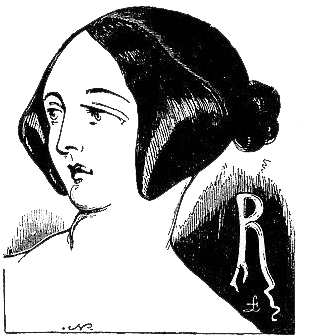 Hairstyle: In the portrait, Ada’s hair appears to be dressed in the classic early Victorian tripartite up-do. This blog has excellent pictures and instructions: Locks of Elegance Braided Victorian Hairstyle. The hair is combed flat and parted in the middle; then the hair in front (from the ears forward) is pulled into two sections. The remaining back section is braided or coiled into a chignon. The two front sections are combed flat against the face, and then looped back to meet up with the chignon. These two front sections can also be braided, which makes the looping back easier. Note that the look of this hairstyle is very different from later up-dos in the nineteenth century. The way the front sections are drawn forward and down is distinctive.
Hairstyle: In the portrait, Ada’s hair appears to be dressed in the classic early Victorian tripartite up-do. This blog has excellent pictures and instructions: Locks of Elegance Braided Victorian Hairstyle. The hair is combed flat and parted in the middle; then the hair in front (from the ears forward) is pulled into two sections. The remaining back section is braided or coiled into a chignon. The two front sections are combed flat against the face, and then looped back to meet up with the chignon. These two front sections can also be braided, which makes the looping back easier. Note that the look of this hairstyle is very different from later up-dos in the nineteenth century. The way the front sections are drawn forward and down is distinctive.
You do need to have longish hair to pull this off. If your own hair won’t do, you might consider an inexpensive brown wig that you can comb and braid.
The Vestal Virgins were the six priestesses who tended the sacred flame of Vesta, goddess of the hearth, in ancient Rome. They were far and away the most privileged women in Roman society, and in fact they were the only women who were granted the basic legal rights that male citizens possessed automatically. Unlike other Roman women, the Vestals could make wills, vote, and live free from the control of their male relatives. What they couldn’t do was have sex. Each Vestal took a 30-year vow of celibacy as a child, and the punishment for breaking that vow was death. A rather horrible death, too: the unchaste Vestal was buried alive.
But aside from the whole buried-alive thing, the Vestals enjoyed an enviable position at the top of Roman society. They had enormous prestige—everybody considered them holy—and extraordinary privileges. Their very existence was thought to be essential to the health of the Roman state. They traveled through the city accompanied by special bodyguards, had the right-of-way everywhere they went, and occupied seats of honor at public games and performances. Their persons were sacrosanct, and the penalty for injuring a Vestal was death. They also lived in a lavish mansion staffed by servants. All in all, it wasn’t a bad trade-off for celibacy.
Our costume is based on ancient descriptions of the Vestals’ clothing, with a generous assist from the archaeologists and modern reenactors who have done so much to bring those descriptions to life. The pieces we suggest, from left to right:
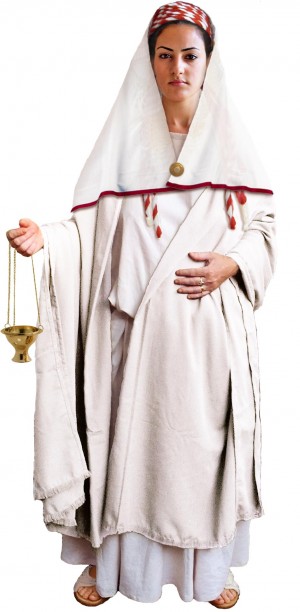 1. White tunic. The Vestals wore a tunic of fine white linen that was probably similar to the Ionic chiton of ancient Greece. This convenient reenactment version is available in polycotton, muslin, or gauze. Just make sure you get it in white. You can also make your own tunic with two flat sheets; scroll down to the bottom of this post for instructions.
1. White tunic. The Vestals wore a tunic of fine white linen that was probably similar to the Ionic chiton of ancient Greece. This convenient reenactment version is available in polycotton, muslin, or gauze. Just make sure you get it in white. You can also make your own tunic with two flat sheets; scroll down to the bottom of this post for instructions.
2. White flat sheet for the palla. The palla was the Roman woman’s counterpart to the toga. It was just a rectangle of fabric about the size of a modern twin flat sheet, which is exactly what we suggest you use. The palla was commonly made of wool, but could also be made of linen, cotton, or silk. Wrap it around you like a big shawl in whatever way seems comfortable; fortunately it didn’t require the complicated draping and folding that the man’s toga did.
3. Fine Italian white virgin wool crepe with crimson felt ribbon for the suffibulum. The suffibulum was the veil worn by Vestals. It was made of white wool and bordered with “purple,” which was really what we would call red. Along with the infula (#6), it was probably the most distinctive and sacred part of the Vestal’s attire. You can of course use any plain white fabric—even a cut-up sheet or pillowcase—but for an authentic touch, use real wool. One yard of that white wool fabric will give you a 58″ x 36″ rectangle. Get two yards of the crimson felt ribbon and attach it to the cut edges of the fabric with Res-Q tape or fabric glue. If you want to edge the entire rectangle in the felt ribbon, get six yards. Drape the finished suffibulum over your head and pin it at your chest with the fibula (next).
4. Round brooch for the fibula (from eBay). The fibula was the fastening pin of the ancient world. There were two basic kinds: the bow fibula, which looked like a safety pin, and the plate fibula, which was flat like a modern brooch. Vestals seem to have worn the plate kind, possibly set with precious stones, to pin the suffibulum closed on the chest. Just get a simple round brooch like this with a non-faceted stone (no facets in Roman times).
5. Thurible (hanging censer). For burning incense or carrying the sacred flame of Vesta with you. These inexpensive brass censers are made in India. They come in a variety of sizes, and are also usually available at Amazon and on eBay.
6. Super bulky wool yarn in red and white for the infula. The infula consisted of strips or braids of red and white wool wrapped around the head, with the free ends hanging down as loops or streamers on the shoulders. The style of the infula probably varied over the centuries, and modern reenactors all have their own particular ways of recreating it. Our inspiration is this version by A.R.S. Historia Romana, an Italian reenactment group:
Get one skein each of the red and white yarn and ply or braid them together. Wrap the resulting two-tone rope around your head several times like a crown, and tie it off in the back. Let the free ends hang down over your shoulders in front. Then drape the suffibulum over your head and secure it to the infula with discreet pins.
Shoes: The Vestals wore white sandals or shoes made from the skin of sacrificial animals, which is definitely not something we’re interested in recreating. Instead we suggest these nice vegan-friendly gladiators from Shiekh:
Hair: The hairstyle worn by the Vestals was an elaborate arrangement of braids called the seni crines. Hairdresser-archaeologist Janet Stephens has done a superb job of recreating it:
But if you can’t manage the seni crines, don’t worry; the suffibulum and infula will cover up your hair anyway.
How to make an Ionic chiton: The Ionic chiton was the larger and more complicated of the two basic styles of Hellenistic chiton. The smaller Doric chiton was narrow and sleeveless; the Ionic chiton involved twice as much fabric, with the extra length used as sleeves. Both were popular in the ancient world. (The Latin word tunica is a cognate of the Greek word chiton.) For the Ionic chiton you’ll need two flat sheets or fabric rectangles, some safety pins or hem tape, and pins for the top edge—either safety pins or fancy brooches. You’ll also need a cord or belt to cinch your waist.
Finally, a note for those familiar with ancient Roman clothing: Although many commenters have assumed that the Vestals also wore the stola over their tunics, this is by no means certain (Staples 1998; DiLuzio 2012). Given the historical ambiguity and the arguments of those who believe the Vestals did not wear the stola, we think the safest bet is what we’ve proposed here: a voluminous white tunic with a palla wrapped around the body.
Illustration credits: Our main illustration shows various recreations of Vestal attire by modern reenactors and archaeologists. The large photo is of a ceremony performed by the Associazione Culturale Gruppo Storico Romano. The small round images at the bottom are, from left to right: a Vestal reenactment by Les Amis de Kleio en Provence; the Vestal hairstyle recreation by hairdresser-archaeologist Janet Stephens (the model is Rachael Pietra); Adriana Serpi of the Associazione Culturale S.P.Q.R. in costume as the chief Vestal; and a Vestal reenactment by A.R.S. Romana Historia.
And: Special thanks to the anonymous backer who sponsored this costume through our Kickstarter campaign. Thank you!
When we first decided to do a costume for Hecate—the goddess of witchcraft, the night, and crossroads—we thought we would do a classic Greek look, the way the ancients saw her. But we ran into an interesting dilemma. Hecate is unusual among ancient goddesses in that she has a fully developed modern iconography that is actually quite different from her classic appearance—though she is of course still the same goddess. The ancient Greeks and Romans typically pictured Hecate as a youngish woman in a chiton, wearing a cylindrical headdress and holding torches. The modern version of Hecate is still holding torches, but she’s often depicted as a wise crone in a very wizardish cloak. The gorgeous painting in our main illustration above (by Antonella Platano) is a perfect example. And you have to admit, it’s pretty freaking cool. So, we decided to go with modern Hecate.
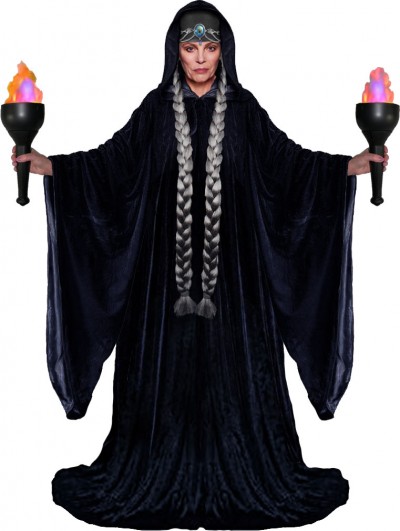 Here are the pieces we suggest, from left to right:
Here are the pieces we suggest, from left to right:
1. Black velvet wizard robe from Artemisia Designs. This is a really long robe, so you might want to turn it under in the front so you can walk.
2. Black fez. Wear this under your hood. It’s a nod to the cylindrical headdress worn by ancient Hecate, and also serves as the base for a fabulous circlet (next).
3. Jeweled circlet from Wynddragon’s Treasures. This seller has a slew of circlets available, most of them in the $20 to $30 range. They’re all different and all fabulous.
4. Long grey wig. If your own hair isn’t hip-length grey, get a wig like this and braid it into two plaits. If you find wigs uncomfortable to wear, you can just cut off the braids and attach them to your fez.
5. Faux Flame 4-in-1 Torch. This is a battery-operated faux flame torch that’s convertible; you can hold it as a torch, set it on a table, hang it on the wall, or suspend it from a chain. Here’s a short video of it in action: 4-in-1 Burning Torch Flame Light.
Main illustration credits: The beautiful modern painting of Hecate is from the Universal Goddess Tarot, with illustrations by Antonella Platano and text by Maria Caratti (Lo Scarabeo, 2006); Aeclectic Tarot has purchase links. The statues of Hecate are typical of the triplicate forms that were popular in classical antiquity. The statue on the bottom is a Roman copy of Greek original; it’s in the collection of the Dutch National Museum of Antiquities (Rijksmuseum van Oudheden). The statue on top is dated to the third century CE and is in the collection of the Antalya Museum in Turkey.

